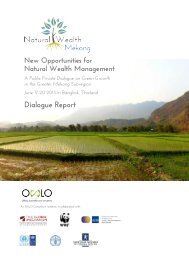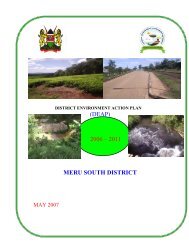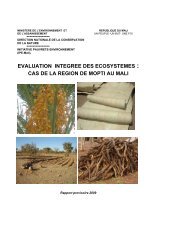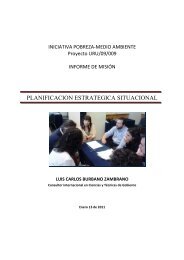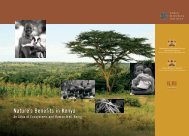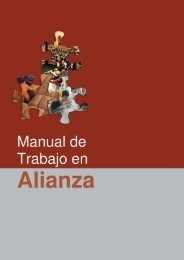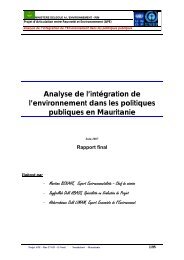WORKSHOP REPORT - UNDP-UNEP Poverty Environment Initiative
WORKSHOP REPORT - UNDP-UNEP Poverty Environment Initiative
WORKSHOP REPORT - UNDP-UNEP Poverty Environment Initiative
You also want an ePaper? Increase the reach of your titles
YUMPU automatically turns print PDFs into web optimized ePapers that Google loves.
GOB-<strong>UNDP</strong>-<strong>UNEP</strong> <strong>Poverty</strong> <strong>Environment</strong> <strong>Initiative</strong><br />
Annex 3: Case Study 3<br />
Linking poverty and environment with respect to challenges and opportunities in the<br />
management of energy, pollution/waste management and climate change<br />
Energy sector is the engine of socio-economic growth. For sectors such as transport, health,<br />
education, agriculture, tourism, mining and manufacture to prosper, sustainable energy must be<br />
available in the right quality and quantity. The status of energy in Botswana is typical the other<br />
SADC countries: over-dependency of low quality biomass energy (92%), indoor air pollution and<br />
burden on women and children- spending many productive hours (up to 3.3 hours per occasion)<br />
carrying heavy loads over long distances (5.3 km). Often the firewood is sourced from natural forest<br />
in unsustainable manner resulting in deforestation and associated loss of land/soil cover, erosion and<br />
land degradation. Deforestation also reduces carbon sink.<br />
Rapid urbanisation in Botswana is putting pressure on authorities to meet the increasing demand for<br />
such services as water, sanitation and waste management. Lack of adequate supply of these<br />
essential services would expose the population to the risk of water and vector borne diseases.<br />
Various studies have shown that climate change will affect southern Africa countries including<br />
Botswana. Climate change may result in reduced rainfall (up to 20%) some areas and floods in other<br />
area. It may also affect the spread of diseases (malaria, anthrax, diarrhoea). Reduced rainfall will<br />
result in water scarcity and generally affect biomass productivity (this will have an impact on<br />
firewood availability). According to World Bank reports, climate change impacts will affect more the<br />
poor populations of the world (especially sub-Saharan Africa) due to their low adaptive capacity.<br />
Within countries, the poorer communities will be more negatively affected.<br />
What the government of Botswana aspires is to:<br />
1. Energy sector: Investment in the activities that would enhance energy efficiency, increase<br />
access to cleaner energy sources and reduce burden on women/ children, deforestation and land<br />
degradation;<br />
2. Pollution and waste management: Investment in water and waste water management in<br />
order to reduce burden of disease and provide healthy environment to the people in both urban and<br />
rural areas; and<br />
3. Climate change: Investment in adaptation measures in various sectors e.g. agriculture<br />
(drought resistant varieties), health sector (reduce risk of malaria/ diarrhoea/ anthrax) and water<br />
sector (demand side management).<br />
Assignment<br />
You have been invited to participate in a task force that will develop a Communication strategy that<br />
would contribute a long term solution to the poverty-environment challenges affecting the<br />
government of Botswana as outlined above.<br />
You may use (but not limited to) the guiding questions below:<br />
Part A<br />
1. What would be an ideal future scenario does the government aspire (vision)?<br />
2. How do we get to this scenario?<br />
3. What needs to be changed?<br />
4. Who are the main stakeholders?<br />
5. How is each one affected?<br />
6. How can we engage the stakeholders?<br />
7. What are the obstacles and opportunities for engagement?<br />
8. What do you want to change in the identified stakeholders?<br />
Part B<br />
9. What do we want to communicate? (the message content)<br />
10. How do we communicate to the different stakeholders? (channels of communication)<br />
31



